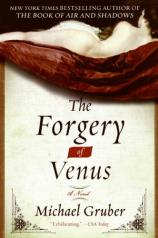The Forgery of Venus
Review
The Forgery of Venus
Charles (Chaz) P. Wilmot, Jr. --- graduate of Columbia University, son of renowned painter C. P. Wilmot, Sr., husband, father, drug user --- has a troubling past, and he wants to tell someone about it. He attends a party thrown by a Columbia alumnus. There, he contacts an old college buddy and passes him a CD containing an unbelievably curious story: the story of Chaz Wilmot’s adventures since his friend last saw him. After listening to the CD, it’s hard to know what to make of it.
“A bitter fellow, Wilmot, even back then, and it should not have surprised me that he came to a bad end. Whether the story he tells is merely remarkable or literally fantastic, I still cannot quite decide.”
So what was Chaz up to during all those years?
Well, he took some trips, physically and psychedelically; ran through several relationships (some of them even lasted); and went in search of his own style of painting. Whether he found it is the $64,000 question. Or maybe the 64-million-dollar question.
It turns out that Chaz can imitate the great masters. In fact, just for fun --- and some much needed cash --- he did just that. He painted several Hollywood stars in the style of, say, Goya or Vermeer. Or Velazquez. He is particularly intrigued by Velazquez. He even dreams of him. Or does he actually become him? Chaz knows more about the Spanish painter than a mere reading of art books could have told him. He seems intimately familiar with the politics of the mid-1600s, and the doings of the royal court, for whom Velazquez painted. In fact, Chaz’s life becomes so intertwined with Velazquez’s that even he has trouble figuring out what is real and what is imagined.
In fairness to Chaz, the drug study he was a part of may have enhanced his susceptibility to hallucinations, for indeed the experimental drug salvinorin did some strange things to his head. But it may have had nothing whatsoever to do with the strangeness in his head, or with what happened later.
To start with, Chaz believes he is a starving artist with a loft in New York, an ex-wife and a dying child. And it may be true. When a well-paying commission comes along, he doesn’t exactly jump at the opportunity, but reluctantly decides that his dire financial situation must be addressed. He is really in no position to turn down the kind of dollars this benefactor is offering. His unease stems from the request that he depart for Venice, Italy, almost immediately, which means leaving Lotte and their sick son. Of course, their son’s burgeoning medical bill is the best reason to go.
Another rather significant worry Chaz has is his recurring flashbacks. He sometimes finds himself waking up in another century. Or is it just the salvinorin kicking back in?
The very lucrative commission in Venice involves restoring a fresco. Actually, it’s more like recreating a fresco, as there is so little left of it that “restoration” is an understatement. Once done, there’s a follow-up offer of another commission. Chaz tries to ignore the nagging thought that, for the kind of money they’re talking about, it simply cannot be legitimate. But the lure of millions often overshadows good judgment. Chaz just keeps getting in deeper and deeper. At least his bank account is looking up, and Lotte will have no problem getting their child the help he so desperately needs. Where, though, does that leave Chaz?
The easy answer is that it leaves Chaz wondering who he is, what life he is really leading, even what year it is. It leaves him asking the question: Am I crazy?
Michael Gruber leaves his readers pondering the concept of reality, the intangibility of time, and the slim grasp we all have on sanity. Gruber’s vast knowledge of art history provides a wonderful diversion from the philosophical questions his tale poses, and subtly introduces a veritable wealth of facts and anecdotes about the lives of the old masters. And the bonus is that he tells a darned fine story, too.
Reviewed by Kate Ayers on January 22, 2011










